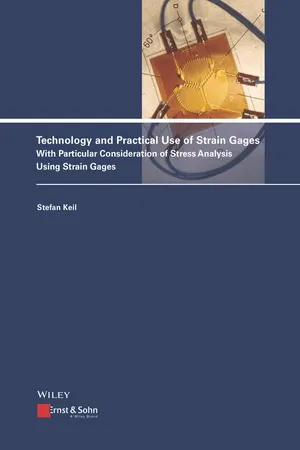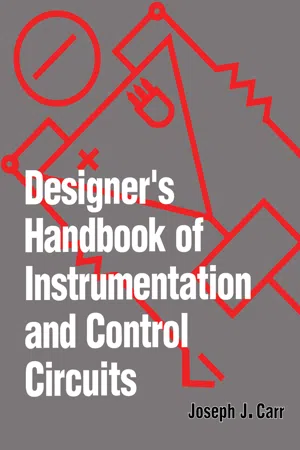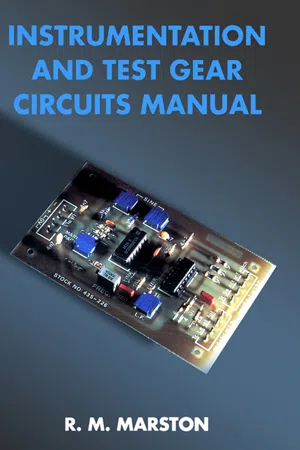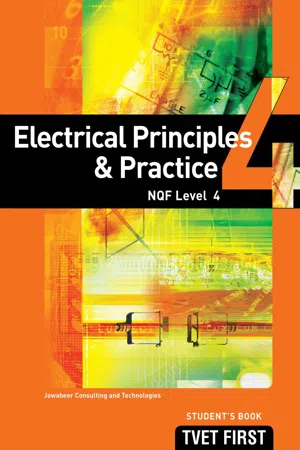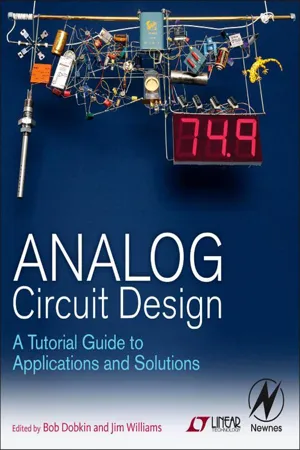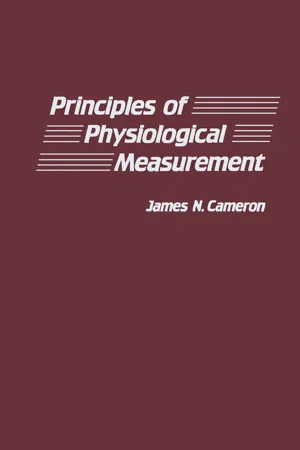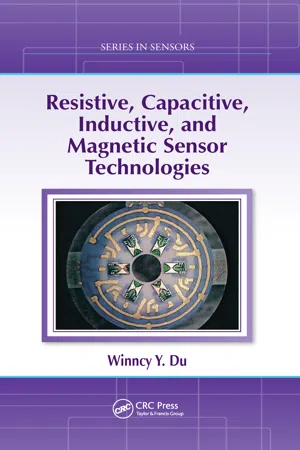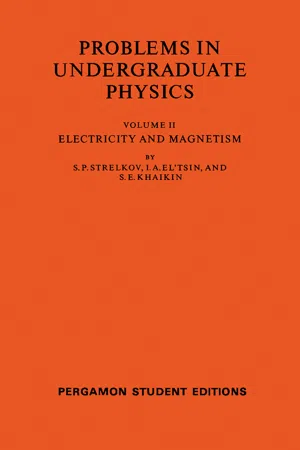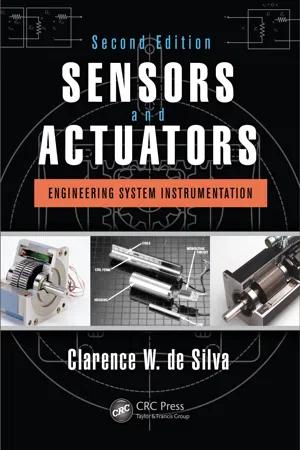Physics
Wheatstone Bridge
A Wheatstone Bridge is a circuit used to measure an unknown electrical resistance by balancing two legs of a bridge circuit. It consists of four resistors and provides a precise way to measure resistance. When the bridge is balanced, the ratio of the two known resistances is equal to the ratio of the two unknown resistances, allowing for accurate resistance measurements.
Written by Perlego with AI-assistance
Related key terms
1 of 5
10 Key excerpts on "Wheatstone Bridge"
- eBook - ePub
Technology and Practical Use of Strain Gages
With Particular Consideration of Stress Analysis Using Strain Gages
- Stefan Keil(Author)
- 2017(Publication Date)
- Ernst & Sohn(Publisher)
4 The Wheatstone Bridge Circuit4.1 Circuit Principle
Even about 100 years before the invention of the strain gage the English scientists Hunter-Christie and Wheatstone were working on the measurement of the resistance of metal connecting wires, resulting in the invention of the bridge circuit with which it was possible to measure resistances even with unstable voltage sources [4.1,4.2]. A brief account of the historical background was given in Chapter 1 . The circuit which was later named after Wheatstone became the most important basic circuit in widespread use for strain gage measurements.Figure 4.1 shows schematically the basic structure of the Wheatstone Bridge circuit in the two graphical forms usually found today. The two forms are electrically identical. The bridge circuit consists of four bridge arms with the resistances R1 to R4 which are here arranged on the four sides of a parallelogram. The effect of the circuit is that if it is excited with a voltage applied to opposite points, the voltage on the other two corner points, that is the output voltage, is dependent on the ratios of the resistances in the four arms of the bridge. For example, if all four resistances in the arms of the bridge are identical, then the output voltage is equal to zero. If a change occurs in one resistance, the effect on the output voltage is a measure of this change in resistance.The usual forms of representing the Wheatstone Bridge for measurements using strain gagesFig. 4.1This effect is used for measurements with strain gages by measuring the change of resistance of a strain gage connected in one arm of the bridge in the manner described above. The output voltage of the circuit is then a measure of the strain.The supply voltage VB is normally between 1 V and 10 V for strain gage measurements. If this voltage is applied to points 2 and 3 of the bridge circuit illustrated in Figure 4.1 , then the bridge output voltage VM between points 1 and 4 is zero when identical resistances are present in all four arms of the bridge, that is if R1 = R2 = R3 = R4 . The bridge is therefore said to be balanced when the output voltage VM = 0 for an applied supply voltage of VB - eBook - PDF
- Joseph J. Carr(Author)
- 2012(Publication Date)
- Academic Press(Publisher)
A Wheatstone Bridge circuit can have these properties. W e can use strain gage elements for one, two, three, or all four arms of the Wheatstone Bridge. Figure 5-5C shows a circuit in which two strain gages (SGI and SG2) are used in two arms of a Wheatstone Bridge, with fixed resistors Rl and R2 forming the alternative arms of the bridge. It is usually the case that S G I and S G 2 are configured so that their actions oppose each other,- that is, under stimulus, S G I will have resistance R + h, and SG2 will have resistance R - h, or vice versa. One of the most linear forms of sensor bridge is the circuit of Fig. 5-5D in which all four bridge arms contain strain gage elements. In most such sensors, all four strain gage elements have the same resistance (R), which will usually be a value between 50 and 1000 Ω. Recall that the output from a Wheatstone Bridge is the difference between the voltages across the two half-bridges. We can calculate the output voltage for any of the standard configurations from the equa-tions given here (assuming all four bridges have nominally the same resistance, R): One active element: V Q = Vh/4R (accurate to ± 5% if h < 0.1) Two active elements: V Q = Vh/2R Four active elements: V 0 = Vh/R where V Q is the output potential in volts (V), V the excitation potential in volts (V), R the resistance of all bridge arms, and h the quantity AR, which is the change in resistance in response to the applied stimulus. SENSOR SENSITIVITY The sensitivity factor (P) relates the output voltage (V) to the applied stimulus value (Q) and the excitation voltage. In most cases, the BALANCING AND CALIBRATING A BRIDGE SENSOR 97 sensor maker will specify a number of microvolts (or millivolts) output potential per volt of excitation potential per unit of applied stimulus. In other words, P = V O /V/Q 0 (5-3) or, written another way, P = V 0 /VQ (5-4) where V Q is the output potential, V the excitation potential, and Q one unit of applied stimulus. - eBook - PDF
- Charles A. Gross, Thaddeus A. Roppel(Authors)
- 2012(Publication Date)
- CRC Press(Publisher)
349 Sensors and Instrumentation 7.5.1 Bridge Circuits Bridge circuits are widely used as sensor interface circuits . The principle employed is to measure the offset that results from the deviation of a sensor element (e .g ., resistance) from its nominal value . Bridges can form part of a null-seeking circuit, in which feedback is used to force the sensor element back to its nominal value . In this case, the output is measured as the amount of feedback required to null the bridge . Such null-seeking circuits are employed, for example, in accelerometers, where the feedback is used to keep the mov-ing element near zero deflection which maximizes linearity while helping to prevent damage from overdriving the moving element . The resistor Wheatstone Bridge circuit consists of four circuit branches, each containing one resistor, as well as an ac or dc voltage bias . Each leg contains one resistor . If just one branch contains a variable resistor, the bridge is called ¼-active (“quarter-active”) . If there are two branches with varying resistors, the bridge is called ½-active (“half-active”) . Bridges with all four branches containing varying resistors are called full-active . Figure 7 .8 shows a ¼-active resistive bridge powered by a dc bias source V DC . The output of the bridge is the difference between the voltages V A and V B indicated in Figure 7 .8 . The resistor labeled R X is the resistor whose value is desired to be measured . This is often a sensor element, for example a thermistor (a temperature-sensitive resistor), a photoresistor (resistance changes with light intensity), a piezoresis-tor (a force-sensitive resistor used in pressure sensors and accelerometers), or a strain gauge (in which resistance depends on the amount of stretching) . The other three resistors labeled R f are fixed resistors . The value of R f is chosen V DC V B V A + + – – V OUT R f R f R f R x = R f + Δ R FIGURE 7.8 Wheatstone Bridge circuit used to interface a resistive sensor. - R. M. Marston(Author)
- 2013(Publication Date)
- Butterworth-Heinemann(Publisher)
Bridges and C -R boxes 73 ΙΟμΗ to ÎOOH. Both of these types of instrument are derived from the ancient (1843) Wheatstone Bridge circuit, and it is well worth studying this in order to learn the finer points of bridge design. The 1843 pattern Wheatstone resistance-measuring bridge uses the basic Figure 4.1 circuit and consists of a pair of d.c.-energized potential dividers (R 2 /R and R y IR x ) with a sensitive meter wired between them. R 2 and Ri have a 1:1 division ratio, and are known as the 'ratio arms' of the bridge; R x is the 'unknown' resistor, and R y is a calibrated variable resistor. In use, R x is fixed in place and R y is then adjusted until a zero or 'null' reading is shown on the meter, at which point the two dividers are generating equal output voltages and the bridge is said to be 'balanced' or 'nulled'; under this condition the ratio R y IR x equals R 2 IR equals unity, and the R x value thus equals that of R y the bridge's balance is not influenced by variations in energizing voltage. A major feature of this original version of the Wheatstone Bridge is its very high null sensitivity. Thus, if the bridge is energized from 10V d.c, 5V is developed across all resistors at balance, and the meter reads zero volts; a shift of a mere 0.1 per cent will then give a 5mV reading on the meter. In prac-tice, this circuit can, when using a fairly simple null-detecting d.c. amplifiers, be expected to have a 'null sensitivity' factor (i.e. per-centage out-of-balance detection value) of about 0.003 per cent. A major disadvantage of this 1843 pattern bridge is that R y needs a vast range of values if it is to balance all possible values Figure 4.1. Original (1843) version of the basic Wheatstone Bridge. 74 Instrumentation and Test Gear Circuits Manual Τ Ratio L / / ^ j a r m s i ^ T I A J ~jr À-ç M e t e r Figure 4.2. Conventional version of the Wheatstone Bridge. of R x .- eBook - PDF
Electrical Principles & Practice NQF4 SB
TVET FIRST
- Jowaheer Consulting and Technologies(Author)
- 2014(Publication Date)
- Macmillan(Publisher)
Hence, the potential voltage at B is equal to the potential voltage at D and therefore: V AB = V AD I 1 P = I 2 R ... Equation 1 Also: V BC = V DC I 1 Q = I 2 X ... Equation 2 Dividing Equation 2 by Equation 1: I 1 Q = I 2 X I 1 P I 2 R Q = X P R Therefore X = RQ P The Wheatstone Bridge is unsuitable for the measurement of very low and very high resistances. Figure 2.21: Long-shunt method I 1 I 2 S 1 S 2 R A P Q C X B G Figure 2.22: A Wheatstone Bridge Did you know? Sir Charles Wheatstone (1802–1875) was an English scientist responsible for many scientific breakthroughs in the Victorian era. These included the stereoscope (a device for displaying three-dimensional images) and the Playfair cipher (an encryption technique). However, Wheatstone is best known for his contributions in the development of the Wheatstone Bridge, originally invented by Samuel Christie. The Wheatstone Bridge is used to measure an unknown electrical resistance. He also played a role in the development of telegraphy. R x V s I v I A I A V D 42 Module 2: Measuring instruments Example 2.2 In a Wheatstone Bridge KLMN, a resistor of unknown value is connected between K and L. When the bridge is balanced, the resistance between L and M is 120 Ω, between M and N it is 30 Ω and between K and N it is 60 Ω. Calculate the value of the unknown resistance. Given: R LM = 120 Ω; R MN = 30 Ω; R KN = 60 Ω Solution Let the unknown resistance value be x Ω R LM = R MN R KL R KN 120 = 30 x 60 30 x = 120 × 60 x = 120 × 60 30 x = 240 Ω Practical applications of the Wheatstone Bridge A common application of the Wheatstone Bridge in industry is to monitor sensor devices such as strain gauges. Such devices change their internal resistance according to the specific level of strain (or pressure, temperature, liquid level and so on) and serve as the unknown resistor R x . - eBook - ePub
Analog Circuit Design
A Tutorial Guide to Applications and Solutions
- Bob Dobkin, Jim Williams(Authors)
- 2011(Publication Date)
- Newnes(Publisher)
32
Bridge circuitsMarrying gain and balance
Jim WilliamsBridge circuits are among the most elemental and powerful electrical tools. They are found in measurement, switching, oscillator and transducer circuits. Additionally, bridge techniques are broadband, serving from DC to bandwidths well into the GHz range. The electrical analog of the mechanical beam balance, they are also the progenitor of all electrical differential techniques.Resistance bridges
Figure 32.1 shows a basic resistor bridge. The circuit is usually credited to Charles Wheatstone, although S. H. Christie, who demonstrated it in 1833, almost certainly preceded him.1 If all resistor values are equal (or the two sides ratios are equal) the differential voltage is zero. The excitation voltage does not alter this, as it affects both sides equally. When the bridge is operating off null, the excitation’s magnitude sets output sensitivity. The bridge output is nonlinear for a single variable resistor. Similarly, two variable arms (e.g., RC and RB both variable) produce nonlinear output, although sensitivity doubles. Linear outputs are possible by complementary resistance swings in one or both sides of the bridge.Figure 32.1 The Basic Wheatstone Bridge, Invented by S. H. ChristieA great deal of attention has been directed towards this circuit. An almost uncountable number of tricks and techniques have been applied to enhance linearity, sensitivity and stability of the basic configuration. In particular, transducer manufacturers are quite adept at adapting the bridge to their needs (see Appendix A, “Strain gauge bridges”). Careful matching of the transducer’s mechanical characteristics to the bridge’s electrical response can provide a trimmed, calibrated output. Similarly, circuit designers have altered performance by adding active elements (e.g., amplifiers) to the bridge, excitation source or both. - eBook - PDF
- James Cameron(Author)
- 2012(Publication Date)
- Academic Press(Publisher)
The 7805 regulator must have a good heat sink attached to it, preferably with some heat transfer paste applied to the contact surface (a zinc oxide sunburn ointment will do). The circuit is internally protected against overload, however, and will not burn out with the output short-circuited. 3.5. THE Wheatstone Bridge 55 R 1 * T T-R3 —©— R 2 *v yT R 4 Fig. 3.18 The Wheatstone Bridge. The current through the meter shown in the center is zero when RiR 4 = JR 2 ^3-The bridge may be used in various ways for measurement of resistance based signals (see text). 3.4.4. Modular Power Supplies Several manufacturers now offer complete modular power supplies in a variety of output voltage and current combinations. A typical unit will be encapsulated in a 2.5 x 5 x 10 cm package, and may have output capabilities of ± 15 V at 150 mA each, and + 5 V at 1 A, with only a few mV voltage ripples at the highest current loads. These units are convenient but considerably more expensive than the simple supplies given above. The choice is a matter of time, supply requirements, and cost. 3.5. THE Wheatstone Bridge A simple but enormously useful circuit for physiological measurements of many kinds is the Wheatstone Bridge, shown in Fig. 3.18. This circuit, originally described for resistance measurement by Christie in 1833 (and later made known by Wheatstone), consists of four resistance elements, R 1 -R 4 , arranged in such a way that if R1/R2 = R3/R4, then the potential between the output points A and B is zero and the bridge is said to be balanced. For resistance measurement, one of the fixed arms, say R 1? is replaced by the unknown resistor, and the bridge is balanced by a known adjustable resistor at one of the other positions. The values of the three known arms are then used in the ratio calculation to obtain the unknown arm's value. This circuit - Winncy Y. Du(Author)
- 2014(Publication Date)
- CRC Press(Publisher)
A constant cur-rent is passed through L 1 and L 4 ; while L 2 and L 3 measure the voltage drop across the RTD. With a constant current, the voltage is strictly a function of the resistance R T and a true measurement is achieved. This connection provides a high degree of accuracy although it is more expensive than two- or three-wire connections. 6.5.3 W HEATSTONE B RIDGE -D RIVEN M EANS 6.5.3.1 Wheatstone Bridge Driven by a Constant Voltage There are four basic Wheatstone Bridge configurations for resistive sensors driven by a constant voltage: • Single-element variation (Figure 6.7a). This configuration is suited for a single sensor (a thermistor, an RTD, or a strain gauge). All the resistances are nominally equal, except the sensor that varies by an amount Δ R . V out is nonlinearly related to Δ R by V R R R V out ex / = + Δ Δ 4 2 ( ) (6.20) V ex V out R B D A C R + uni0394 R R R (a) V ex V out R B D A C R + uni0394 R R R + uni0394 R (b) V ex V out R B D A C R + uni0394 R R R – uni0394 R (c) V ex V out B D A C R + uni0394 R R – uni0394 R R – uni0394 R R + uni0394 R (d) FIGURE 6.7 Four common Wheatstone Bridge configurations under a constant voltage drive: (a) single-element; (b) two-diagonal-element; (c) two-adjacent-element; and (d) four-element variations. 322 Resistive, Capacitive, Inductive, and Magnetic Sensor Technologies • Two-diagonal-element variation (Figure 6.7b). This configuration is used for two identical sensors mounted diagonally to each other. For example, strain gauges with their axes in parallel, pressure or flow meters that have one for sensing and the other for reference. In this case, the bridge output is twice that of the single-element varying bridge: V R R R V out ex / = + Δ Δ 2 2 ( ) (6.21) • Two-adjacent-element variation (Figure 6.7c). This structure contains two adjacently mounted elements, but they vary in opposite directions (e.g., two identical strain gauges: one mounted on the top of a flexing surface, and the other on the bottom).- eBook - PDF
Electricity and Magnetism
Problems in Undergraduate Physics
- S. P. Strelkov, I.A. El'Tsin, S. E. Khaikin(Authors)
- 2013(Publication Date)
- Pergamon(Publisher)
in order for the resistance as read on the ohmmeter scale to be 10 times less than the values of r x l 118. What is the ratio of the arms l t , l 2 of the bridge illustrated in Fig. 22 when it is balanced? The other two arms contain electric 22 PROBLEMS lamps as shown. In what conditions can this question be answered, when only the data marked on the lamp bases are available? 119. A voltage Fis applied to a Wheatstone Bridge. The galvano-meter has a resistance R and indicates a current J, when resistances x> r 2 , r 3 , r 4 are connected in the arms of the bridge. Find the un-known resistance FIG. 22 FIG. 23 120. Find the resistance R between the points A and B for the circuit illustrated in Fig. 23. The resistances of the various branches are shown on the diagram. 121. Resistance measurements on a Wheatstone Bridge have maxi-mum accuracy when the resistances of adjacent arms are equal, i.e., when R ± = R 2 (Fig. 24). Prove this for the case when the galvano-meter resistance is very high, so that the current through the gal-vanometer is negligible. FIG. 24 Hint. Find the relationship between the relative variation in R x and the voltage variation Δ V at the galvanometer. 122. Is a bridge balance destroyed if the current source and the galvanometer change places? Is the sensitivity affected? DIRECT CURRENT LAWS 23 123. In the Wheatstone Bridge of Fig. 22, the scale position of the slider A on the slide wire enables the unknown resistance to be determined directly in ohms, if a constant 1 ohm resistance is connected in the right-hand arm. What are the corresponding re-sistances when the slider is located at £, f, $ the length of the slide wire from its left-hand end? Also, where is the slider located if the unknown resistance is equal to 1 ohm, 10 ohm? Draw the relevant graph. - eBook - PDF
Sensors and Actuators
Engineering System Instrumentation, Second Edition
- Clarence W. de Silva(Author)
- 2015(Publication Date)
- CRC Press(Publisher)
Closer examination of Equation 5.56 reveals that only the adjacent pairs of resistors (e.g., R 1 with R 2 , and R 3 with R 4 ) have to be identical in order to achieve this environmental compensation. Even this requirement can be relaxed. In fact, compensation is achieved if R 1 and R 2 have the same temperature coefficient and if R 3 and R 4 have the same temperature coefficient. (Constant voltage) – + A R 2 v ref R L R 1 R 3 R 4 B v o – + Load (high) Small i R L FIGURE 5.37 Wheatstone Bridge circuit. 361 Analog Sensors and Transducers Example 5.7 Suppose that R 1 represents the only active strain-gauge and R 2 represents an identical dummy gauge in Figure 5.37. The other two elements of the bridge are bridge-completion resistors, which do not have to be identical to the strain gauges. For a balanced bridge, we must have R 3 = R 4 , but they are not necessarily equal to the resistance of the strain-gauge. Let us determine the output of the bridge. In this example, only R 1 changes. Hence, from Equation 5.56, we have d d v v R R o ref = 4 (5.7.1) 5.8.1.2 Bridge Constant Equation 5.7.1 assumes that only one resistance (strain gauge) in the Wheatstone Bridge (Figure 5.37) is active. Numerous other activating combinations are possible, however; for example, tension in R 1 and compression in R 2 , as in the case of two strain gauges mounted symmetrically at 45° about the axis of a shaft in torsion. In this manner, the overall sensitivity of a strain-gauge bridge can be increased. It is clear from Equation 5.56 that if all four resistors in the bridge are active, the best sensi-tivity is obtained if, for example, R 1 and R 4 are in tension and R 2 and R 3 are in compression, so that all four differential terms have the same sign.
Index pages curate the most relevant extracts from our library of academic textbooks. They’ve been created using an in-house natural language model (NLM), each adding context and meaning to key research topics.
